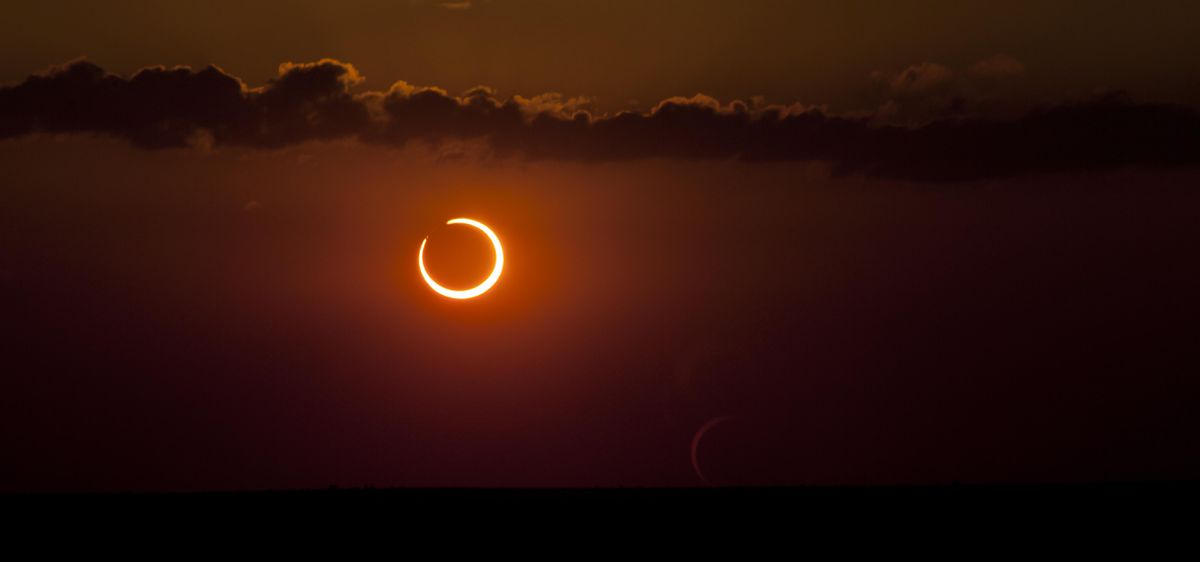
An ‘Eclipse Season’ Is Here And 2021’s Two Biggest Astronomical Events Are Imminent
A ring of fire annular solar eclipse is coming to North America. GettyIt will all start with a full Moon on May 26, 2021.But this full Flower Moon will be remarkable for two reasons: Its 2021s biggest supermoon and will appear 8% bigger in the sky than the average full Moon because it will be at its closest to Earth. Its also a total lunar eclipse Blood Moon that will be visible to an entire night-side of Earthand that includes some of North America. Just like clockwork, this Super Flower Blood Moon Eclipse marks a point in the orbit of the Earth by the Moon that sets-off a chain of events that then causes a solar eclipse half-an-orbit later, when the New Moon is between the Earth and the Sun. On June 10, 2021 the supermoon will have become a micro moonnot a term thats in popular use, but it does help explain whats going on. Whereas the supermoon was close to Earth, this New Moon will be the farthest from Earth. The result is an annular solar eclipse that will be visible as a ring of fire around the Moon from parts of Canada, Greenland and Russia, and a huge partial solar eclipse at (or soon after) sunrise from northeast U.S. states. Europe will also see its biggest partial solar eclipse since 2015 as up to 32% of the Sun gets covered by the Moon. Note: never look at the partial phases of any solar eclipse without proper eye protectionand that means solar eclipse glasses. Lunar eclipses are completely safe at all times. But why do two eclipses follow each other? And what causes eclipsesand an eclipse season? The Moons orbit of Earth is tilted by 5º to the ecliptic, but it must cross the ecliptic twice each ... [+] month.Universal Images Group via Getty ImagesWhat is an eclipse season?Eclipses are always twins (and sometimes triplets). Eclipse seasons are a period of between 31 and 37 days that occurs ever 173 days, so around twice per year. The one coming-up is 2021s first of two.An eclipse season occurs when Moon is perfectly lined-up to intersect the eclipticthe apparent path of the Sun through our daytime sky and the plane of Earths orbit of the Sun. The lunar nodes are the two points where the Moon's orbital path crosses the ecliptic, the Sun's ... [+] apparent yearly path on the celestial sphere. Tom Ruen (Wikipedia/public domain) The Moons orbit of Earth is tilted by 5º to the ecliptic, but it must cross the ecliptic twice each month. Those two positions are called nodes. Usually it reaches these nodes when the the Sun and Moon seem far apart from our point of view on Earth. This is why an eclipse does not occur each and every New Moon (because the Moon is above or below the Sun) and full Moon (because the Moon is above or below Earths shadow). Its only when the Moon is precisely at those nodes during New Moon or full Moon that an eclipse can result. A lunar eclipse occasionally happens at full Moon when the Earth is between the Sun and Moon, blocking sunlight from reaching the lunar surface. A solar eclipse occasionally happens New Moon when the Moon is between the Earth and Sun.However, when the Moon does reach one of those nodes, its going to hit the other eclipse node two weeks later, and sometimes for a third time two weeks after that, too. The Moon in mid-total eclipse, on January 20, 2019, with it shining beside the Beehive star cluster. ... [+] (Photo by: Alan Dyer/VWPics/Universal Images Group via Getty Images)VWPics/Universal Images Group via Getty ImagesWhen is the 2021s second eclipse season?2021s second eclipse season begins on November 19, 2021 when a partial lunar eclipsea Frosty Half-Blood Moon Eclipsewill see 97% of the Moon enter Earths dark umbral shadow and turn reddish. It will be visible from North and South America, Australia and Asia. It will be followed by the celestial icing on the cakea dramatic total solar eclipse in Antarctica that will be visible (clear skies allowing) low in the sky above the floating icebergs of the Wedell Sea. Disclaimed: I am the editor of WhenIsTheNextEclipse.comWishing you clear skies and wide eyes.
……Space
Comments
Leave a comment in Nestia App